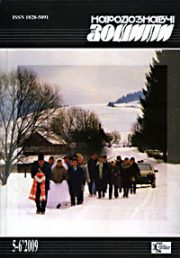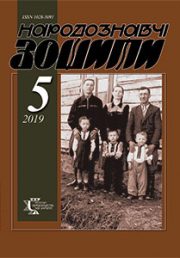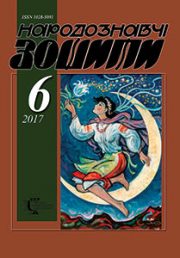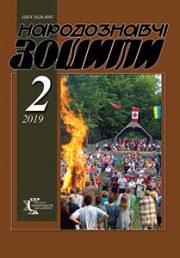The Ethnology Notebooks. 2022. № 3 (165), 633—646
UDK [[903.2:930]:251/255-162.2](477.7)”652″
DOI https://doi.org/10.15407/nz2022.03.633
THE CULT OF THE GODDESS ASTARTE ON THE BOSPORUS: BETWEEN HISTORIOGRAPHICAL CONSTRUCT AND REALITY
KORCHAK Andrii
- ORCID ID: https://orcid.org/0000-0002-3895-9677
- Ph. D. student (History),
- Ivan Franko National University of Lviv,
- Department of Archaeology and Special Historical Studies,
- 1, Universytetska Str., 79000, Lviv, Ukraine,
- Contacts: e-mail: naum2109@ukr.net
Abstract. The study of the beliefs of the ancient Greek colonies in the northern Black Sea region has a long, almost two-hundred-year history. Many researches on this topic have been published. However, the information presented in them is often outdated. Moreover, a number of Russian researchers, using fragmentary archeological materials, construct doubtful scientific hypotheses based on them, and this hypotheses often result misinterpretation of sacred monuments, confusion of different in nature cults, and other similar cases.
One of such problems is the question of presence of the cult of the Middle Eastern goddess Astarte in the Bosporus Kingdom during the IV century BC — III century AD. According to the statements, this belief manifested itself in the image of goddesses such as Astara, Aphrodite-Urania, Anahita. There is an opinion that Astarte on the Bosporus, like all other goddesses, was a manifestation of the so-called «female deity». Of course, such incertitude greatly enhances the relevance of the proposed study.
The purpose of this article is an attempt to find answers to the following questions: was the cult of the goddess Astarte widespread in the Bosporus Kingdom? Did it express itself in the worship of goddesses known in this region, or were these deities represented there by their own cults?
The following methods were used in the article: system-structural analysis, comparative-historical, typological, descriptive and semantic methods to study the source base, namely sculptural, numismatic monuments and individual myths. Based on the use of comparative-historical and typological methods, it was possible to outline a list of relevant scientific approaches to the topic, prepare their brief reviews, verify, present the value and originality of the views of certain authors, depict the state of their scientificity.
The results of the study identified several important facts. Artifacts discovered in the Bosporus, previously associated with Astarte, are likely to represent the popular Aphrodite-Urania. The cults of this goddess, as well as the little-known Astara, were independent in nature and originated in Asia Minor (Ionia and Bithynia). There are no monuments which can testify to the fact of the worship of the Iranian goddess Anahita in the Bosporus Kingdom. Instead, the notion of «the great female deity», personified by almost every goddess of the Northern Black Sea region, is only a collective representation of a number of representatives of Russian historical science.
Keywords: The Bosporan Kingdom, cults of Astarte, Sanerg and Astara, Aphrodite Urania, «great female deity».
Received 14.04.2022
REFERENCES
- Struve, V.V. (Ed). (1965). Corpus of Bosporan inscriptions. Moskva; Leningrad: Nauka [in Russian].
- Shaub, I. Yu. (2010). From the history of the study of the religious life of the Bosporus VI—IV centuries BC. Vestnik Sankt-Peterburgskogo universiteta (Series 2, issue 2, pp. 104—114) [in Russian].
- Dubois, F. (1843). Travel around the Caucasus, among the Circassians and the Abkhases, in Colhide, in Georgia, in Armenia and in the Crimea; with a geographical, picturesque, archaeological, geological, etc. atlas (Vol. V). Paris [in French].
- Ashik, A.B. (1848). Bosporan kingdom with its paleographic and tombstones, painted vases, plans, maps and views (Part I). Odessa [in Russian].
- Gerts, K.K. (1870). Archaeological topography of the Taman Peninsula. Moskva: Izdanіe Moskovskago Arkheologichekago Obshchestva [in Russian].
- Gerts, K.K. (1876). Historical overview of archaeological research and discoveries from the end of the 18th century to 1859. Moskva [in Russian].
- Rozanova, N.P. (1949). Dedicatory inscription to Sanerg and Astara. Monument to Queen Komosaria. Vestnik Drevney istorii, 1 (28), 86—93 [in Russian].
- Turayev, B.A., Borozdin, I. N., & Farmakovskiy, B.V. (Eds). (1918). Ancient world in the south of Russia. Selected sources. Moskva [in Russian].
- Gaydukevich, V.F. (1949). Bosporus kingdom. Moskva; Leningrad: Izdatel’stvo Akademii nauk SSSR [in Russian].
- Latyshev, V.V. (Ed). (1890). News of ancient Greek and Latin writers about Scythia and the Caucasus (Vol. I: Greek writers). Sankt Peterburg [in Russian].
- Strabon. (1964). Geography: in 17 books, translation, article and comments by Stratanovsky G.A. Moskva: Nauka [in Russian].
- Rusyayeva, A.S. (2002). Bosporan queen Kamasaria. Bosporskiye issledovaniya (Vol. 2, pp. 109—124) [in Russian].
- Shelov-Kovedyayev, F.V. (1985). The history of the Bosporus in the VI— IV centuries B. C. In The oldest states on the territory of the USSR. Materials and research 1984 (Pp. 5—187). Moskva: Nauka [in Russian].
- Tolochko, P.P. (1998). Long History of Ukraine (Vol. 2: Scythian-Sarmatian era). Kyiv: Instytut of arkheology NAN of Ukrayine [in Ukrainian].
- Yaylenko, V.P. (1995). Women, Aphrodite and the priestess of Spartokids in new Bosporus inscriptions. Zhenshchina v antichnom mire. Sbornik statey (Pp. 204—272). Moskva: Nauka [in Russian].
- Maksimova, M.I. (1956). Ancient cities of the southeastern Black Sea region. Sinop. Amis. Moskva, Leningrad: Izdatel’stvo Akademii nauk SSSR [in Russian].
- Koshelenko, G.A. (2010). Religion and cults. In Antichnoye naslediye Kubani (Vol. ІІ, pp. 354—416). Moskva: Nauka [in Russian].
- Rostovtsev, M.I. (1913). The idea of the monarchical power of Scythia and the Bosporus. Izvestіya Imperatorskoy arkheologicheskoy kommisіi (Issue 49, pp. 1—62, 133—140) [in Russian].
- Gerodot. (1972). History in nine books, translation and notes by Stratanovsky G.A. Leningrad: Nauka [in Russian].
- Rostovtsev, M.I. (1918), Hellenism and Iranism in the South of Russia, General essay. Petrograd: Ogni [in Russian].
- Rostovtzeff, M. (1919). The Cult of the Great Goddess in Southern Russia. Revue des Etudes Grecques (Vol. 32, pp. 146—150, 462—481) [in French].
- Rostovtzeff, M. (1922). Iranians and Greeks in South Russia. Oxford: At the Clarendon Press.
- Gaydukevich, V.F. (1951). New studies of Ilurat. Kratkiye soobshcheniya o dokladakh i polevykh issledovaniyakh instituta istorii material’noy kul’tury (Issue XХХVII, pp. 196—211) [in Russian].
- Gaydukevich, V.F. (1958). Ilurat. Results of archaeological research in 1948—1953. Materialy i issledovaniya po arkheologii SSSR, 85: Bosporan cities. II. Works of the Bosporus Expedition 1946—1953 (Pp. 9—148) [in Russian].
- Shkorpil, V.V. (1914). Report on excavations in the city of Kerch and on the Taman Peninsula in 1911. Izvestіya Imperatorskoy arkheologicheskoy kommisіi (Issue 56, pp. 1—74) [in Russian].
- Kruglikova, I.T. (1952). Clay stamp from Kimmerik. Kratkiye soobshcheniya o dokladakh i polevykh issledovaniyakh instituta istorii material’noy kul’tury (Issue XLIII, pp. 110—115) [in Russian].
- Kruglikova, I.T. (1966). About the cult of the supreme female deity in the Bosporus in the II—III centuries A. D. In Culture of the ancient world (Pp. 110—115). Moskva: Nauka [in Russian].
- Blavatskiy, V.D. (1964). Panticapaeum. Essays on the history of the Bosporus. Moskva: Nauka [in Russian].
- Sokol’skiy, N.I. (1964). Sanctuary of Aphrodite in Kepoi. Sovetskaya arkheologiya, 4, 101—118 [in Russian].
- Yaylenko, V.P. (1977). Notes on Greek vocabulary and onomastics. In History and culture of the Ancient World (Pp. 216—224). Moskva: Nauka [in Russian].
- El’nitskiy, L.A. (1960). From the history of ancient Scythian cults. Sovetskaya arkheologiya, 4, 46—55 [in Russian].
- El’nitskiy, L.A. (1970). Scythian legends as cultural and historical material. Sovetskaya arkheologiya, 2, 64—74 [in Russian].
- Marchenko, I.D. (1960). On the question of the cults of the Asian Bosporus. Vestnik Drevney istorii, 2 (72), 101—107 [in Russian].
- Marchenko, I.D. (1977). About the cult of Aphrodite on Taman. In Istoriya i kul’tura Antichnogo Mira (Pp. 121—126). Moskva: Nauka [in Russian].
- Artamonov M.I. (1961). Anthropomorphic deities in the religion of the Scythians. Arkheologicheskiy sbornik. Skifo-sarmatskoye vremya (Issue 2, pp. 57—87) [in Russian].
- Grakov, B.N. (1970). Scythians. Popular science essay. Moskva: Izdatel’stvo Moskovskogo universiteta [in Russian].
- Rayevskiy, D.S. (1977). Essays on the ideology of the Scythian-Sak tribes. Experience in the reconstruction of Scythian mythology. Moskva: Nauka; Glavnaya redaktsiya vostochnoy literatury [in Russian].
- Bunin, D.S. (2001). On the issue of chthonic elements in the cult of Aphrodite in the Bosporus. Bosporan phenomenon: colonization of the region, formation of policies, formation of the state. Materials of the international scientific conference (Part 1, pp. 127—131). Sankt Peterburg: Izdatel’stvo Gosudarstvennogo Ermitazha [in Russian].
- Bunin, D.S. (2004). On the question of the circumstances of the formation of the cult of Aphrodite Urania in the Bosporus. The Bosporan Phenomenon: Problems of Chronology and Dating of Monuments. Materials of the international scientific conference (Part 1, pp. 106—111). Sankt Peterburg: Izdatel’stvo Gosudarstvennogo Ermitazha [in Russian].
- Bunin, D.S. (2005). The cult of Aphrodite in the Bosporus (VI century BC— III century AD). (Cand. hist. sci. diss. abstr.). Moskva [in Russian].
- Bunin, D.S. (2007), Aphrodite of Bosporus in the 2nd century BC — 3rd century AD development of the image in the local religious system. Bosporus Phenomenon: Sacred Meaning of the Region, Monuments, Finds. Materials of the international scientific conference (Part 1, pp. 54—59). Sankt Peterburg: Izdatel’stvo Gosudarstvennogo Ermitazha [in Russian].
- Bessonova, S.S. (1983). Religious representations of the Scythians. Kiyev: Naukova dumka [in Russian].
- Shaub, I.Yu. (1998). About the cult of Aphrodite in the Bosporus. The Bosporus Kingdom as a Historical and Cultural Phenomenon. Conference materials (Pp. 54—57). Sankt Peterburg: Izdatel’stvo Gosudarstvennogo Ermitazha [in Russian].
- Shaub, I.Yu. (1999). The cult of the Great Goddess among the local population of the Northern Black Sea region. Stratum Plus. VASh (Vysshaya arkheologicheskaya shkola) — arkheologicheskiy zhurnal, 3: Skifskiy kvadrat. Sankt Peterburg; Chisinau; Odessa, 207—223 [in Russian].
- Shaub, I.Yu. (2007). Myth, cult, ritual in the Northern Black Sea region (VIІ—IV centuries BC). Sankt Peterburg: Izdatel’stvo Sankt-Petersburgskogo gosudarstvennogo universiteta; Filologicheskiy fakul’tet [in Russian].
- Shaub, I.Yu. (2010). Hellenic Traditions and Barbarian Influences in the Religious Life of the Greek Colonies of the Northern Black Sea Region (VI—IV centuries BC). (Dr. hist. sci. diss. abstr.). Sankt Peterburg [in Russian].
- Koshelenko, G.A. (1999). Bosporan variant of the myth about the death of giants. Drevnosti Bospora (Issue 2, pp. 147—160) [in Russian].
- Tokhtas’yev, S.R. (1983). Bosporan legend about Aphrodite Apaturos. Vestnik Drevney istorii, 2 (164), 111—117 [in Russian].
- Rusyayeva, A.S. (2005). Religion of the Pontic Hellenes in Antiquity: Myths. Sanctuaries. Cults of Olympian Gods and Heroes. Kyyev: Stilos [in Russian].
- Kharko, L.P. (1946). The Cult of Aphrodite on the Cimmerian Bosporus (Abstracts of Candidate of Historical Sciences thesis defended at a meeting of the Academic Council of the Faculty of Philology of Moscow State University on December 24, 1942). Kratkiye soobshcheniya o dokladakh i polevykh issledovaniyakh instituta istorii material’noy kul’tury (Issue XIII, pp. 137—141) [in Russian].
- Kharko, L.P. (1941). Fragment of a frieze depicting giants from Stanitsa Tamanskaya. Sovetskaya arkheologiya (Issue VII, pp. 81—93) [in Russian].
- Kharko, L.P. (1950). On the five-column temple depicted on the Bosporan coins of the 2nd c. Vestnik Drevney istorii, 1 (31), 197—205 [in Russian].
- Sokol’skiy, N.I. (1973). The cult of Aphrodite in Kepi at the end of the 6th— 5th centuries BC. Vestnik Drevney istorii, 4 (126), 88—92 [in Russian].
- Alekseyeva, E.M. (1997). The ancient city of Gorgypia. Moskva: Editorial URSS [in Russian].
- Rusyayeva, A.S. (2001). Aphrodite Urania is the patroness of the Milesian-Pontic colonization. Bosporan phenomenon: colonization of the region, formation of policies, formation of the state. Materials of the international scientific conference (Part 1, pp. 17—21). Sankt Peterburg: Izdatel’stvo Gosudarstvennogo Ermitazha [in Russian].
- Kondakov, N.P. (1879). Greek terracotta figurines. (From the Notes of the Odessa Imperial Society of History and Antiquities). Odessa [in Russian].
- Pototskiy, S.P. (1962). Traces of the influence of Hellenistic cults in the Northern Black Sea region. Palestinskiy sbornik: Istoriya i filologiya stran Blizhnego Vostoka (Issue 9 (72), pp. 115—120) [in Russian].
- Heuzey, L. (1923). Louvre National Museum. Catalog of antique terracotta figurines. Oriental Figurines and Asian Island Figurines. Paris: Musee Nationaux palais du Louvre [in French].
- Solomonik, E.I. (1973). From the history of religious life in the North Pontic cities of the Late Antiquity. Vestnik Drevney istorii, 1 (123), 55—77 [in Russian].
- Kobylina, M.M. (1978). Images of Oriental Deities in the Northern Black Sea Region in the First Centuries A.D. Moskva: Nauka [in Russian].
- Kobylina, M.M. (1949). Terracotta Fanagoria local production. Vestnik Drevney istorii, 1 (28), 107—113 [in Russian].
- Blavatskiy, V.D., & Shelov, D.B. (1955). Intelligence on the Kerch Peninsula. Kratkiye soobshcheniya o dokladakh i polevykh issledovaniyakh instituta istorii material’noy kul’tury, 58, 100—113 [in Russian].
- Lukian, Samosatskiy. (2001). Works (Vol. 2). Sankt Peterburg: Aleteya [in Russian].
- Publiy, Ovidiy, Nazon., & Shervinsky S. (1977). Metamorphoses. Moskva: Khudozhestvennaya literatura [in Russian].
- Publiy, Ovidiy, Nazon, & Gasparov, M. (1973). Elegies and small poem. Moskva: Khudozhestvennaya literatura [in Russian].
- Gigin, & Ruban, A.I. (1997). Astronomy. Sankt Peterburg: Aleteya [in Russian].
- Gigin, & Torshilov, D. (2017). Myths. Sankt Peterburg: Aleteyya [in Russian].
- Anokhin, V.A. (1986). Coinage of the Bosporus. Kyev: Naukova dumka [in Russian].
- Anokhin, V.A. (2011). Antique coins of the Northern Black Sea region. Catalog. Kyev: Stilos [in Russian].
- Frolova, N.A. (1997). Coinage of the Bosporus (middle of the 1st century BC — middle of the 4th century AD) (Part І: Coinage of the Bosporus 49/48 BC—210/211 AD). Moskva: Editoral URSS [in Russian].







